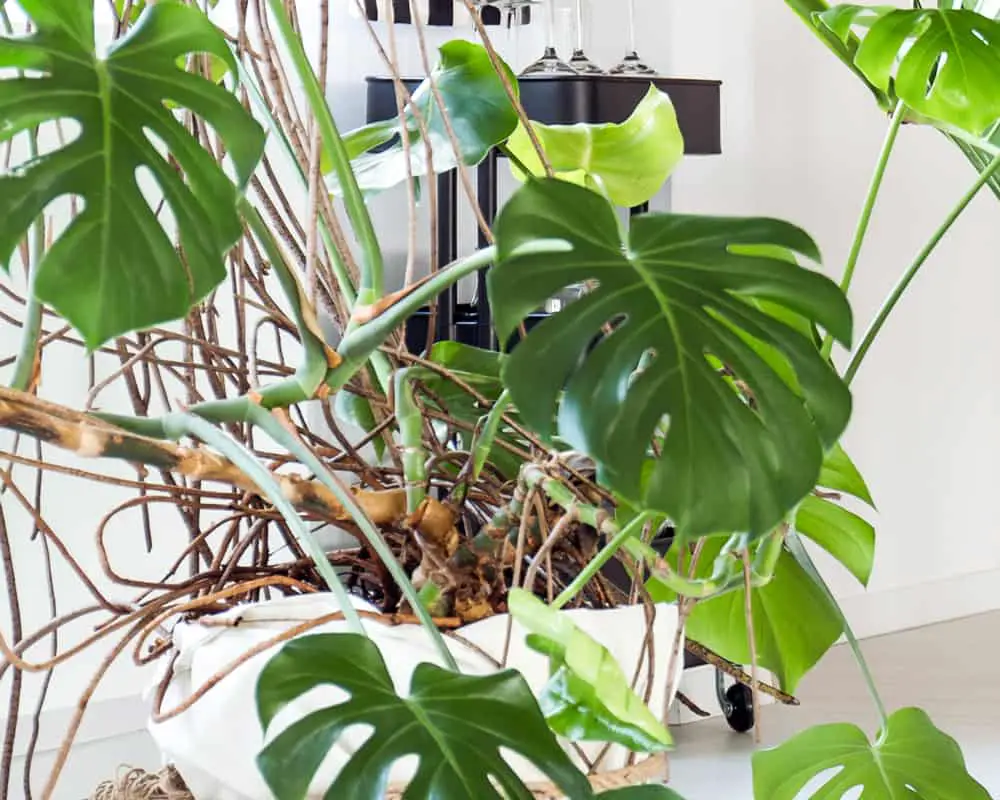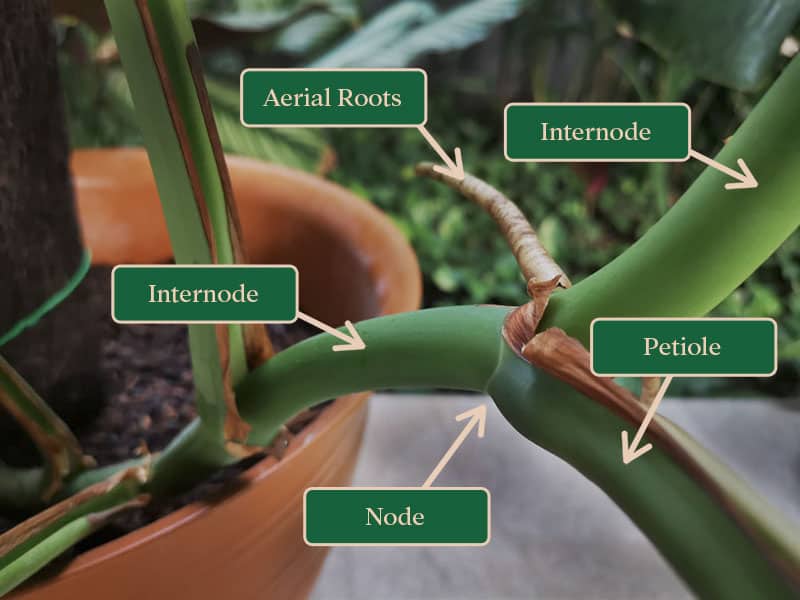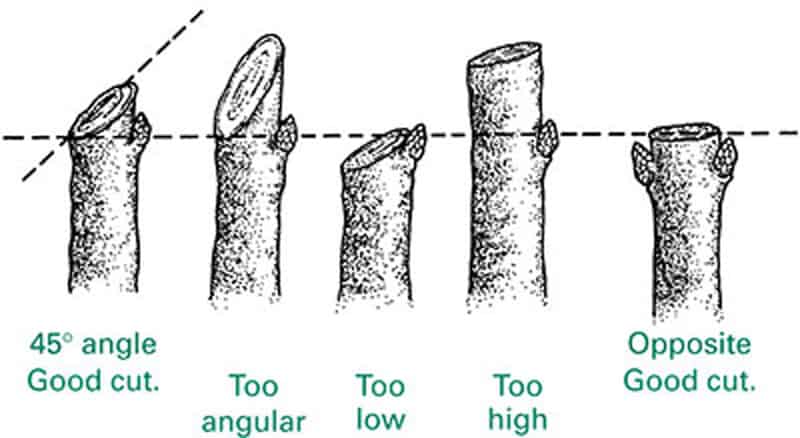Does your Monstera plant need a touch-up? Monsteras are known as fast-growing plants and so it is necessary to regularly prune them to keep them looking at their best.
When pruning, cut any overgrown or dying leaves below the Monstera node with a clean sharp shear. The best time to prune your Monstera is in early spring, which is when it enters its growing season.
In this article, we will discuss everything you need to consider before pruning your Monstera and what to do with the cuttings after.
Let’s get started!
Should I Consider Pruning my Monstera?

Why does my Monstera need pruning?
Pruning is optional, but here are three main reasons why you should consider pruning your Monstera plant regularly:
- Pruning removes dead or dying leaves that are no longer helping with photosynthesis but still consume nutrients and water resources. Trimming these leaves means freeing up energy to support the healthy leaves and new growth
- The rapid growth and widespread of Monstera make it susceptible to becoming messy, but pruning can help maintain a neat appearance.
- When leaves have been infested with disease or pest, removing the damaged leaves helps to prevent spreading to other parts of the plant.
How often should you prune?
The frequency of pruning will depend on the age and size of your Monstera. Typically, a young Monstera will need pruning once a year. A more mature and denser plant may need to be trimmed monthly to maintain an even shape.
Not to mention, some species like the Monstera Adansonii, Siltepecana, and Peru grow at a much faster rate compared to Monstera Deliciosa. You might need to prune them monthly.
How to Prune a Monstera?
There are a few things you should consider before pruning your Swiss Cheese plant:
- Prune in early Spring
- Prepare the tools needed
- Identify Monstera nodes
- Plan and decide where to cut
- Trim the aerial roots if needed
If you want to propagate Monstera cuttings, you need to prune at least two inches below its node with a clean and sharp shear. Remove disease and dying leaves by trimming above the node instead.
Prune in early Spring
The best time to prune your Monstera is in early spring before its growing season. This is when the days are getting sunnier and plants can heal damage from the pruning faster.
Fall and early Winter are the worst time to prune, as your Monstera will enter dormancy. There is simply inadequate sunlight for photosynthesis to fuel growth and repair damage caused by pruning.
Also read: How to care Monstera in Winter
Prepare the tools needed
You will need to make sure that you have the following items when pruning:
- Pruning shears or a sharp knife
- Thick gloves
When it comes to pruning your Monstera, you need shears that are easy to grasp and a sharp blade.
Pruning with blunt tools can lead to rough, improper cuts that rip the stems, causing larger wounds that require more time to heal.
Don’t forget! Before you start pruning your Swiss cheese plant, make sure you sterilize all tools to prevent diseases from transferring over.
If you have sensitive skin, you should wear gloves as the Monstera plant contains a sap that can cause skin irritation.
Identify the Monstera nodes
Before you cut your plant, it is important to identify the node to decide where you are going to prune the plant.
Nodes are the part of the Monstera from which the new leaves, stems, and aerial roots will grow.

You can identify Monstera nodes by looking for spots on the stem that are lighter and raised higher than most other parts of the stem. Although there may be just one leaf growing from a node, many large plants have several leaves growing from single nodes.
Also read: Can You Propagate Monstera Without Node?
Plan and Decide where to cut
If you want to propagate your Monstera, then you will need to cut at the internode, at least two-inch below the node. This gives enough space for new roots to form.
Keep in mind, when cutting below a node you leave a section of stem that cannot grow new stems and leaves.
When pruning to shape a plant or removing dying leaves, then you should clean cut above the node instead. New growth will grow in the same direction.

Cutting at a 45-degree angle instead of straight across will allow for greater surface area, thus increasing water uptake.
Avoid over-pruning as every cut is a wound to the plant. So if your plant is overgrown, find the most prolific nodes with a lot of stems and leaves coming out of them and prune those areas. That way you can take off a lot without increasing the risk of infection or shock for your plant.
Should you cut the aerial roots?
Aerial roots are the types of roots that grow above the ground rather than below it.
In nature, aerial roots are used as support for Monstera to climb up taller trees they can receive more sunlight in the upper canopy.
They can become extremely long and do not present a pleasant aesthetic. If they are out of control, you may want to consider trimming them.
When cutting aerial roots, make sure to trim them as close to the node without actually cutting the node. Cutting too deep may cause node or stem damage which can lead to an increased risk of disease.
What to do with pruned leaves?
After you have pruned your leaves, you could repurpose the cuttings for other uses such as propagating them or using dead leaves to make compost.
Propagate your cuttings
Propagating your cutting is when you make a new plant from the cuttings of an old plant.
You can root your cuttings in either water or soil. This often depends on your personal preference as to which method you choose to use.
Personally, I like propagating my Monstera cuttings in water so I can see how long the roots have grown and whether there is any rotting.
If you want to put the plant in soil, make sure that it is not overwatered. This can lead to bacteria growth and mold which can hurt or kill your plant cutting.
Use the dead leaves as compost
When you have pruned a plant that had dying or yellowing leaves, it is a good idea to use these leaves as compost.
Composting dead leaves are fairly simple:
- Collect the leaves that you have cut from the plant and place them into a bag. It is a good idea to mix a few grass cuttings into the leaves too.
- Add in a Compost Maker or a Natural Fertilizer as these will accelerate the composting process.
- Be sure to add some moisture into your compost mix if it seems dry and make some holes in your bag so that their air can get to it.
- Store the bag for at least two weeks to get the best results from your homemade compost.
In conclusion
Pruning can make your Monstera happy. You will be able to see new growth and keep it looking good in your living space. It is also an excellent way to stop the disease from spreading from an infected leaf.
If you wish to prune your Monstera, the best time is during early spring. Avoid dormant season as this may harm rather than help the plant.
